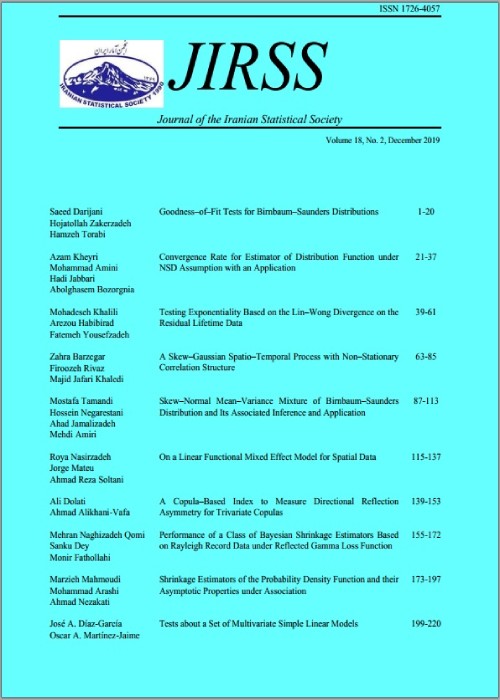فهرست مطالب
Journal of Iranian Statistical Society
Volume:4 Issue: 2, 2005
- تاریخ انتشار: 1384/08/11
- تعداد عناوین: 5
-
-
Page 73The local limit theorem describes how the density of a sum of random variables follows the normal curve. However the local limit theorem is often seen as a curiosity of no particular importance when compared with the central limit theorem. Nevertheless the local limit theorem came first and is in fact associated with the foundation of probability theory by Blaise Pascal and Pierre de Fermat and was originally formalized by Jakob Bernoulli, Abraham DeMoivre and Pierre-Simon Laplace. Here we describe the historical roots of the local limit theorem. We describe how it was supplanted by the central limit theorem in applications. Then we review the revival started by B. V. Gnedenko and we describe modern developments.
-
Page 87Some examples of absurd uniformly minimum variance unbiased estimators are discussed. Two reasons, argued in the literature, for having such estimators are lack of enough information in the available data and property of unbiasedness. In this paper, acceptingboth of these views, we show that an appropriate choice of loss function using a general concept of unbiasedness leads to risk unbiased, admissible and reasonable estimators. For this we extend the Rao- Blackwell theorem using a new way of defining unbiased estimator.
-
Page 97Here, we propose a method of estimation of the derivatives of probability density based wavelets methods for a sequence of m−dependent random variables with a common one-dimensional probability density function and obtain an upper bound on Lp-losses for the such estimators.
-
Page 107Petrov (1996) proved the connection between general moment conditions and the applicability of the strong law of large numbers to a sequence of pairwise independent and identically distributed random variables. This note examines this connection to asequence of pairwise negative quadrant dependent (NQD) and identically distributed random variables. As a consequence of the main theorem (Theorem 2.1), we arrive at an improvement of Marcinkiewicz– Zygmund theorem for pairwise NQD random variables.
-
Page 113The use of the Pareto distribution as a model for various socio-economic phenomena dates back to the late nineteenth century. In this paper, after some necessary preliminary results we deal with Bayes estimation of some of the parameters of interest under an asymmetric LINEX loss function, using suitable choice of priors when thescale parameter is known and unknown. Results of a Monte Carlo simulation study conducted to evaluate the performances of these estimators compared to the MLE’s and MME’s in terms of estimated risks under LINEX loss function.


